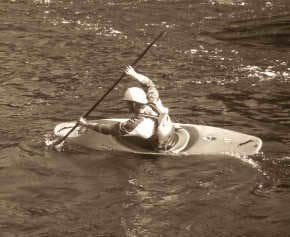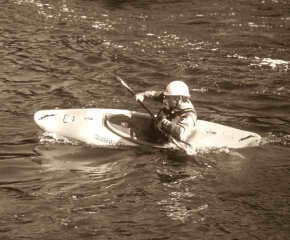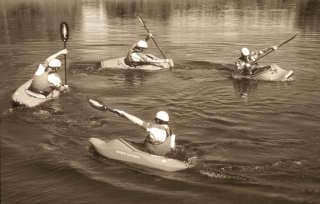The Power Stroke
The Power Stroke is a vertical forward stroke designed to help your kayak accelerate while carving a steady path. As simple as this sounds, it is not an easy stroke to master as whitewater kayaks are designed to turn rather than to stay on track. It is a skill well worth practicing and perfecting though, as the benefits are considerable. The stroke will let you cross eddylines more aggressively and confidently, will help you set up play moves, and will let you boof (keep your bow on the surface when going over drops) more dynamically and in more control than ever before. The practice drill for the Power Stroke is also fantastic for developing your balance and edge control, which are of course two of the most important paddling skills. In this article we're going to look at the Power Stroke while at the same time developing a drill that should become a standard part of your warm up routine.


The goal of this drill is to paddle in a circle using only Power Strokes on the inside of the turn. Start by establishing some forward speed and getting your kayak turning by taking a small sweep stroke. Now get your boat on edge so that it is carving in the direction of the circle you're going to paddle. From this point on, you'll use only vertical forward strokes (Power Strokes) on the inside of your turn to keep your boat carving in a circle. Your success in continuing to carve this circle is based on two things: your ability to balance your kayak steadily on edge and your ability to take forward strokes with a vertical paddle shaft. These vertical forward strokes focus your power on propelling your kayak directly forward. If your strokes aren't quite vertical, then they will be effectively working against the carving momentum of your kayak. Ultimately, this will break the circle that you are trying to carve and your boat will start turning in the other direction. The key to making your forward strokes vertical is reaching across your kayak with your top hand, while keeping your bottom hand in close to the kayak. This is a very committing thing to do, as your paddle provides very little in the way of a brace in this position. You need to rely on your balance alone. Because of this, the natural thing to do is to move your bottom hand out to the side of the kayak, where it can provide some support. The problem with this is that your paddle will no longer be vertical, and your forward stroke will again be fighting your carving momentum. Commit! Expect to flip while trying this! It will take lots of practice, but soon you'll be able to carve circles indefinitely while balancing your boat on a steady edge without the support of your paddle.

As you get more comfortable with this drill, it's time to start adding some power to your strokes. Learning to apply power to your technique is the second step for virtually any drill. Ultimately, you should be able to keep carving controlled circles while putting 100% power into your strokes. One of the best ways to get the utmost power from your Power Stroke is by thrusting your hips forward with each stroke. If your paddle doesn't remain vertical through the stroke, you'll find that your boat changes direction very quickly. As your balance improves, you'll find that you can get your top hand so far across your kayak that your paddle shaft is actually past vertical. This will guarantee that you'll continue carving circles and is a great demonstration of your balance and commitment to your strokes.
Once you're comfortable with the power stroke on flatwater, try using it as you cross through eddylines. It provides a fantastic means of pulling yourself completely across an eddyline and into or out of the current. You'll carve smoother turns and spend much less time getting swirled on eddylines.
Ken Whiting was the 1997/98 World Whitewater Freestyle Champion. He has produced an award-winning series of instructional kayaking books and DVDs, and leads kayaking trips to Chile. Look for his new book 'The Ultimate Guide to Whitewater Kayaking', and video 'The Ultimate Guide to Sea Kayaking'. Check out www.helipress.com
Related Articles
Even though they are flipping over, missing their gates and failing their maneuvers, they still look…
In this video, we're going to look at five kayaking tips that will help make you a better paddler, or…
As a member of the US Surf Kayaking Team I had the honor and privilege to compete in the world…
Eddy turns are the foundation for paddling in current, enabling you to enter and exit river and tidal…


